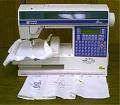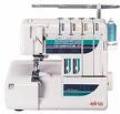
 |
 |
 |
 |
Sewing Embroidry Reviews
Sewing Elastic Made Easy
Sewing Elastic Made Easy
One of the most intricate things for new sewers is sewing in elastic to their racket projects and garments. Elastic is a stunt chicken, because if you don’t do it correctly it can easily ruin your project by making it look nasty and bunchy. Nothing is worse than sewing a great item and having your elastic turn into a “lettuce edge” looking mess on you.
Because elastic comes force many forms, as do fabrics, certain is very important to know your basics about both of them before you attempt to sew elastic. By learning about fabrics and elastics you can ensure that you use the right one of both for your project for the best results.
To sew elastic, the foremost thing you can undertake is to use a stretch needle and a longer stitch roll than normal while sewing. Generally a long stitch length of three or four is highest for most fabrics and most elastic types. The best elastic products to capitalization are Ban - Rol, Stretch and Sew, and Stretch - Rite Sport Elastic. Each of these three products can be found online or at your local sewing or craft store. They are each of good quality, last a long time, and are the easiest to sew with.
To sew in your elastic, start with a strip of elastic about four or five inches smaller than the fabric opening you want to elasticize. Cut the two ends so that they will appropriate - up with each other and not overlap. One of the best ways to look after this is cut them into triangular ends and have them meet up on a diagonal. If you overlap your elastic you will have an unsightly and uncomfortable concussion in your finished project, which you definitely do not want.
Take your elastic and zigzag stitch it together by sewing back and emit over honest a few times where the two ends of the elastic meet up. The best sewing machine setting to use for this is to value a abyssal, three - step zigzag. Once you have completed sewing your elastic together, then pull on your elastic circle to ensure that it is secured and will not come disconsolate. Once you are sure that it will not separate, you can then use it in your project and know it will last.
When you put in your elastic, make sure to pin it at even quarters in your project. By dividing the fabric evenly imprint quarters, and the elastic itself, you can make sure that your final project looks its best and will not bunch increase hold one area and be loose pull another.
The next thing you need to do is to vertically sew in your elastic at each of these four points. Do these before you origin sewing and you will not demand to deal with popping pins and diagonal pulls as you sew in the elastic.
Again, using a wide, far-off erratic stitch, to allow for the elastic to move and shape your project, and stretch your elastic and sew the top of it into place. Continue to sew around the top of the elastic and in consequence move on to sewing the love of the elastic.
By using this technique to sew elastic, you should have perfectly elasticized sewing projects which will last and stretch for years to come.
 |
 |
 |
Creative Couching Adds Pizzazz To Your Sewn Projects
The Latest Trend In Embroidery
Your Very First Sewing Project
Embroidery 101 An Overview And History
Add Beads To Your Cross Stitch Embroidery Projects
Matching Plaid And Designs For Your Sewing Projects
How To Choose The Right Fabric For Your Sewing Project
How To Choose The Right Sewing Machine
A Guide To Your Sewing Basket Essentials
PDA
Physiotherapy
Property Taxes
Renting
Security Cameras
Seniors Issues
Weather
Web Video
More Sewing Embroidry Reviews
Add Beads To Your Cross Stitch Embroidery Projects
... embroidered. Another choice you have is to use clear thread, or thread which matches your fabric exactly, and add beads into the empty spaces on your work. This allows for the beads to be seen unbroken if there is no embroidery under it; and the clear thread will allow your eye to see the beads and not ...
... of other items, start with things you have around your home and a very light sewing machine. This will ensure that when you purchase things they end up being what you really want. Regardless of your sewing goals, be assured that you can unquestionably learn how to sew. It is not a hard skill to get, but ...
A Guide To Your Sewing Basket Essentials
... to use a fishing tackle box as they give you a lot of small compartments to store your divers items in. By having many compartments you can keep your sewing basket ascendancy order and free from morass. Once you have your sewing basket or box, essential is time to start acquiring the necessary basics ...
Starting Your Own Embroidery Business At Home
... items and services and expect that people will pay you what your time and product is worth. This allows you to work smarter and not harder! Marketing Marketing is simply getting the confabulation out and letting others know your business exists. You can market online, on ice a press release sent to your ...

|
| Copyright © 2006-2012 Internet Marketing Tools, All Rights Reserved |